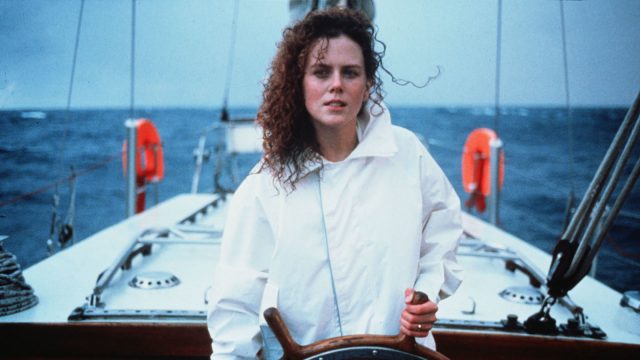An old school suspense film that combines psychological horror and survival thrills, Phillip Noyce’s Dead Calm is gripping and pretty stripped down. But it still makes time for the important questions, like, “Is it just an inherently bad idea to get on a boat with Billy Zane?” and “If you kill a guy out at sea and nobody knows you ever met him, do you even have to report it? Or is that, like, a freebie?”
If you have a soft spot for this kind of mildly elevated potboiler–and as a person who has seen What Lies Beneath more than once, I do–then this one is fairly well-done: beautiful but ordinary people, high tension, clear conflict, claustrophobic/isolated setting, and a minimum of bullshit. Zane turns in a solid performance–suitably overheated and constantly cycling back and forth between moods and delusions–but the heart of the movie is with Sam Neill and Nicole Kidman, who manage to spend most of the story apart and yet still convince us of the strength of their marriage.
They play the Ingrams, John and Rae, who have gone on a long sailing trip to try to pick up the pieces after the sudden death of their son. Their early interactions have a glassy fragility to them: these are people who are trying to want to be alive. Their depressed equilibrium is disturbed when they spot a nearby ship, the first in days; its lone occupant, Hughie (Zane), rows up in a dinghy. Hughie tells a harrowing but disjointed story–the rest of his crew succumbed to botulism, leaving him stranded on a sinking ship with a bunch of days-old corpses–and it pings John as off, especially since Hughie is adamant that they need to leave the boat alone.
John, however, can’t resist going to go look. And that kicks off a chain of events with him on the damaged boat–surrounded by corpses–and Rae stuck sailing off on their own boat with a manic, unpredictable Hughie. Somehow, they both have to stay alive and get back together.
The execution fumbles in places, especially since Rae makes some decisions that feel dictated by the screenplay. But the simplicity of the setup works very well, with two different strains of “what it takes to stay alive” explored thoroughly. And when Kidman and Neill do get to be together, especially towards the end, they have a relaxed and convincing chemistry.
You get at least one moment of problem-solving satisfaction, one moment of triumph, and one moment of fright, and they all hold up; the ocean photography is a nice bonus. This is one of those movies that it’s worth watching from a creative standpoint, too. It has good bones that you could flesh out in any number of ways, and it would make a decent writing exercise to imagine different executions. Great thrillers put you in the characters’ shoes, but merely good ones have the interesting effect of putting you in the director’s. Dead Calm falls neatly and satisfyingly into that category.

